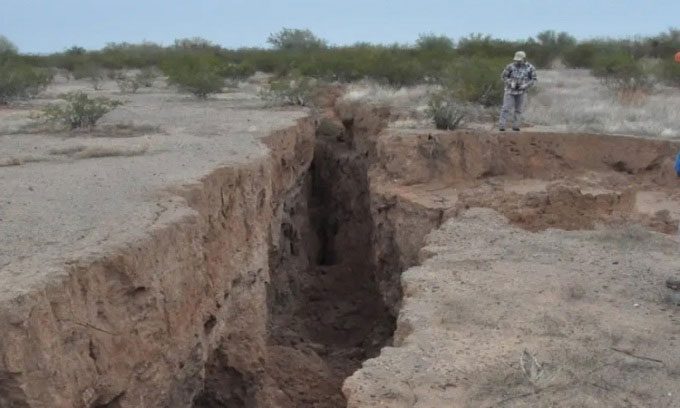The U.S. is depleting groundwater excessively, causing the ground to crack in many areas of the Southwest, with cracks extending up to several kilometers.

Some cracks caused by excessive groundwater extraction can extend for kilometers. (Photo: Joseph Cook)
Enormous cracks resulting from excessive groundwater extraction have been identified in states including Arizona, Utah, and California, Business Insider reported on September 12. Groundwater is one of the main freshwater sources on Earth, providing nearly half of the total drinking water and accounting for about 40% of global irrigation water. However, humans are extracting groundwater faster than the Earth can naturally replenish it. When too much groundwater is drawn from the natural aquifers beneath the surface, the result is ground subsidence, leading to the formation of cracks, according to Joseph Cook, a researcher specializing in earth fissures at the Arizona Geological Survey.
“These cracks are not a natural phenomenon. They are caused by humans,” Cook stated. According to him, cracks are indicative of stress on the ground. They encircle large flat areas that have subsided due to the loss of supporting groundwater. Cracks typically appear in basins between mountains and can destroy homes, roads, canals, and dams, as well as pose threats to people and livestock.
Arizona has been facing this issue for a long time and has been monitoring the cracking phenomenon at least since 2002. The Arizona Geological Survey currently reports 272 kilometers of documented cracks. The New York Times has investigated water levels at tens of thousands of locations across the U.S. The findings reveal that aquifers supplying approximately 90% of the water system in the U.S. are being depleted to a degree that may not be recoverable. Nearly half of the monitored sites have experienced significant water declines over the past 40 years. Four out of ten locations reached all-time low levels in the past decade. It may take centuries, even thousands of years, for aquifers to recover.
According to Cook, some locations in Arizona are beyond saving. The rate of human water use is so high that rainfall does not have enough time to replenish the groundwater beneath the surface. As global temperatures rise, rivers are shrinking, forcing farmers to rely more heavily on freshwater from groundwater sources. The Colorado River, which supplies freshwater to farmers throughout the Southwest, including Arizona, has shrunk by nearly 20% since 2000. If temperatures in the Colorado River basin rise by a few degrees Celsius by 2050, flow could decrease by 10% to 40%.
One of the main issues in addressing the problem of excessive groundwater withdrawal is the lack of coordination. Federal authorities have virtually no regulations regarding groundwater extraction, while the existing management systems are weak and inconsistent across regions. Arizona is no exception. Authorities do not limit the amount of groundwater that can be used, and residents can extract until the water runs out. Cook emphasizes that if humans do not change their habits and allow time for the groundwater to recover, the cracks will continue to expand.



















































